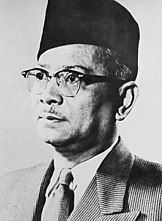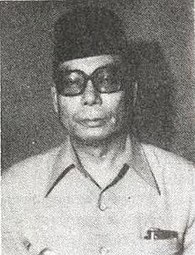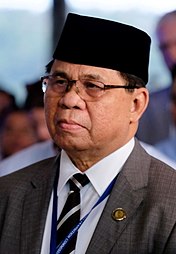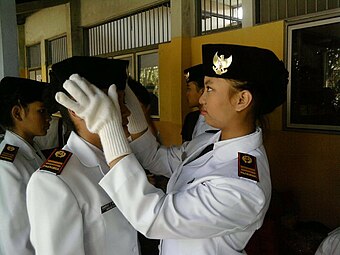Songkok
  Indonesian leader Sukarno and Malaysian leader Tunku Abdul Rahman wearing a peci/songkok. | |
| Type | Traditional cap |
|---|---|
| Place of origin | Brunei, Indonesia, Malaysia, Singapore |
The songkok or peci or kopiah is a cap widely worn in Brunei, Indonesia, Malaysia, Singapore, the southern Philippines and southern Thailand, most commonly among Muslim males. It has the shape of a truncated cone, usually made of black or embroidered felt, cotton or velvet. It is also worn by males in formal occasions such as weddings and funerals or festive occasions such as the Eid ul-Fitr and Eid al-Adha holidays. In Indonesia, the peci is also associated with the nationalist movement.[1]
Names[]
It is called "songkok" in Sumatra and the Malay Peninsula.[2] While in Java, it is called "kopiah" or "kopeah".[3] It is also known widely in Indonesia as "peci", although peci has a more ellipse shape and sometimes decorated.[2] The name "peci" was probably derived from the Dutch word petje means literary "small hat", or possibly derived from the Turkish fez instead.[citation needed] All names refer to the same object.
Origin[]
This section needs attention from an expert in Fashion. (June 2019) |
The origin of the songkok can be traced to the fez, which was adopted by the Ottomans in 1826 and subsequently spread to South Asia and to the Malay Archipelago (now called Brunei, Indonesia and Malaysia). The songkok used to be worn during the Ottoman Empire and in some parts of Africa. However this may only be part true, as the words themselves can be traced earlier. Kopiah is recorded as being used by Majapahit elite troops (Bhayangkara).[4] Kupiah is recorded in Pigafetta's Italian-Malay vocabulary of 1521.[5] One Brunei newspaper account erroneously states that the songkok became a norm in Malay Archipelago in the 13th century with the coming of Islam in the region.[2] The earliest written mention of the word songkok is in Syair Siti Zubaidah (1840).[6] While traditional triangular Malay headress of Tengkolok or destar is associated with traditional Malay nobles and royalties, songkok on the other hand has become part of traditional Malay men's costume associated with Islam, traditionally worn by local ulamas.
The Royal Malay Regiment of the Malaysian Army have been using the songkok as part of their uniform since under British rule.[7]
Current use[]
Traditionally, songkok is usually associated as a cap worn by Muslim men, during religious or formal state occasions. However, in Indonesia, the songkok has become the national headress with secular nationalist connotations made popular by Sukarno.[1] Numbers of Indonesian nationalist movement activist in early 20th century wore peci such as Sukarno, Mohammad Hatta, and Agus Salim. However, as the first president of Indonesia it was Sukarno that popularised peci — more precisely plain black velvet peci — as national men's cap of Indonesian,[8] and Indonesian male presidents have worn peci as part of their official presidential attire ever since. Indonesian official palace guards also wore peci as part of their uniform. The Paskibraka (Indonesian: pasukan pengibar bendera pusaka) or flag raising squad in Indonesian independence day ceremony also wear peci, and there is even female peci version with curved back. The Betawi people wear the Songkok as their traditional headdress usually colored dark red.
In Malaysia, traditional male Malay attire consists of a songkok, shirt, matching pants, and waist wrap that is called a baju melayu. In a Dewan Undangan Negeri (State Legislative Assemblies) or in Dewan Rakyat (Parliament), all members (regardless of race or religion) within the legislative assembly, are required to wear the songkok (with a gold middle stripe) as a formal custom, at every State Customary Opening of Parliament (or respective State Legislative Assemblies), held once annually, in order to comply with the dress code of each legislative assembly opening.[9][10] This is done to ensure decorum whenever the respective Head of State (Yang di-Pertuan Agong for the Parliament of Malaysia, respective Sultans or Yang diPertua Negeri for each State Legislative Assemblies) is present to open the legislative assembly proceedings for the year. Similarly, all recipients of honorific orders bestowed by either the Yang di-Pertuan Agong (for federal honorific orders) or the Sultan (for each respective state honorific orders), are required to wear the gold-striped songkok along with the official customary attire in Malaysia, to receive their honorific orders in person.
In Singapore, the songkok is not allowed to be worn in government schools, as part of the school uniform, as Singapore is officially a secular state and all religious headgear is not allowed to be worn.[citation needed] It is part of the standard uniform at madrasahs (Islamic religious schools).
In the Philippines, the songkok, known as kopiah or kupya, plays a role in the heraldry of the Sultanate of Sulu, and is part of the traditional wear of Bangsamoro men. It is worn by Bangsamoro and other Filipino Muslim men throughout the archipelago as a formal cap for prayers, and for religious and social functions.
Gallery[]

Men of the Royal Malay Regiment (Rejimen Askar Melayu DiRaja) wearing songkok at bayonet practice, Singapore Island (1941).

EWP Tambunan, a Christian, was known for his habit of wearing red songkok.

Murad Ebrahim, Chief Minister of the Bangsamoro Autonomous Region in Muslim Mindanao, southern Philippines

Female version of peci with curved back, worn by Indonesian flag raising girls squad (Paskibra).
See also[]
- Dhaka topi
- Gandhi cap
- Fez (hat)
- Tengkolok
- Yarmulke
References[]
- ^ Jump up to: a b Hendri F. Isnaeni (10 September 2010). "Nasionalisme Peci" (in Indonesian). Yahoo Indonesia News. Retrieved 10 September 2010.
- ^ Jump up to: a b c Rozan Yunos (23 September 2007). "The origin of the songkok or 'kopiah'". The Brunei Times. Archived from the original on 5 December 2008. Retrieved 13 April 2016.
- ^ Abdullah Mubarok (21 February 2016). "PDIP: Kopiah Bagian Dari identitas Nasional" (in Indonesian). Inilah.com. Archived from the original on 13 April 2016. Retrieved 13 April 2016.
- ^ Nugroho, Irawan Djoko (2011). Majapahit Peradaban Maritim. Suluh Nuswantara Bakti. ISBN 9786029346008.
- ^ Bausani, Alessandro (December 1960). "The First Italian-Malay Vocabulary by Antonio Pigafetta". East and West. 11: 229–248 – via JSTOR.
- ^ Syair Siti Zubaidah MCP text
- ^ Journal of the Society for Army Historical Research. Society for Army Historical Research. 1996.
- ^ Yusep Hendarsyah (28 April 2011). "Peci Hitam dan Identitas Paling Indonesia". Kompasiana. Archived from the original on 12 August 2012. Retrieved 28 March 2012.
- ^ Hubungan Etnik di Malaysia (in Malay). ITBM. 2011. pp. 127–. ISBN 978-983-068-579-3.
- ^ http://www.istiadat.gov.my/wp-content/uploads/2020/12/3.-Pakaian-Rasmi-Istiadat-No.-1-Dress-Bagi-Ahli-Parlimen-dan-Ahli-Dewan-Negara-Siang.pdf
External links[]
| Wikimedia Commons has media related to Songkok. |
- Caps
- Malay clothing
- Philippine clothing
- Indonesian clothing
- History of Asian clothing




